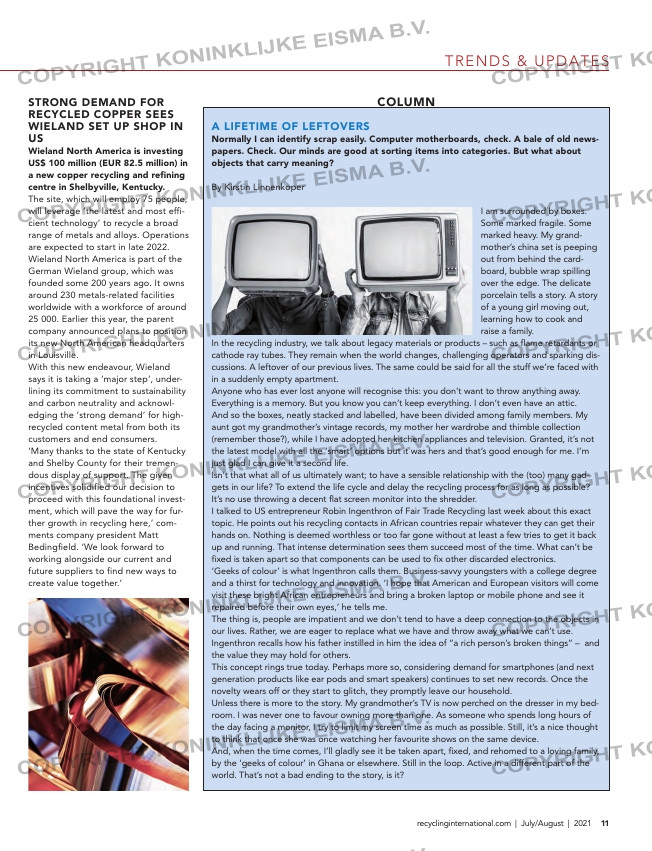Page 11 from: Recycling International July issue | 2021 + TOP 100!

trends & updates
11recyclinginternational.com | July/August | 2021
Fotobijschrift
KadErKoP
??
a lifEtimE of lEftovErs
normally i can identify scrap easily. computer motherboards, check. a bale of old news-
papers. check. our minds are good at sorting items into categories. but what about
objects that carry meaning?
By Kirstin Linnenkoper
I am surrounded by boxes.
Some marked fragile. Some
marked heavy. My grand-
mother’s china set is peeping
out from behind the card-
board, bubble wrap spilling
over the edge. The delicate
porcelain tells a story. A story
of a young girl moving out,
learning how to cook and
raise a family.
In the recycling industry, we talk about legacy materials or products – such as flame retardants or
cathode ray tubes. They remain when the world changes, challenging operators and sparking dis-
cussions. A leftover of our previous lives. The same could be said for all the stuff we’re faced with
in a suddenly empty apartment.
Anyone who has ever lost anyone will recognise this: you don’t want to throw anything away.
Everything is a memory. But you know you can’t keep everything. I don’t even have an attic.
And so the boxes, neatly stacked and labelled, have been divided among family members. My
aunt got my grandmother’s vintage records, my mother her wardrobe and thimble collection
(remember those?), while I have adopted her kitchen appliances and television. Granted, it’s not
the latest model with all the ‘smart’ options but it was hers and that’s good enough for me. I’m
just glad I can give it a second life.
Isn’t that what all of us ultimately want; to have a sensible relationship with the (too) many gad-
gets in our life? To extend the life cycle and delay the recycling process for as long as possible?
It’s no use throwing a decent flat screen monitor into the shredder.
I talked to US entrepreneur Robin Ingenthron of Fair Trade Recycling last week about this exact
topic. He points out his recycling contacts in African countries repair whatever they can get their
hands on. Nothing is deemed worthless or too far gone without at least a few tries to get it back
up and running. That intense determination sees them succeed most of the time. What can’t be
fixed is taken apart so that components can be used to fix other discarded electronics.
‘Geeks of colour’ is what Ingenthron calls them. Business-savvy youngsters with a college degree
and a thirst for technology and innovation. ‘I hope that American and European visitors will come
visit these bright African entrepreneurs and bring a broken laptop or mobile phone and see it
repaired before their own eyes,’ he tells me.
The thing is, people are impatient and we don’t tend to have a deep connection to the objects in
our lives. Rather, we are eager to replace what we have and throw away what we can’t use.
Ingenthron recalls how his father instilled in him the idea of “a rich person’s broken things” – and
the value they may hold for others.
This concept rings true today. Perhaps more so, considering demand for smartphones (and next
generation products like ear pods and smart speakers) continues to set new records. Once the
novelty wears off or they start to glitch, they promptly leave our household.
Unless there is more to the story. My grandmother’s TV is now perched on the dresser in my bed-
room. I was never one to favour owning more than one. As someone who spends long hours of
the day facing a monitor, I try to limit my screen time as much as possible. Still, it’s a nice thought
to think that once she was once watching her favourite shows on the same device.
And, when the time comes, I’ll gladly see it be taken apart, fixed, and rehomed to a loving family,
by the ‘geeks of colour’ in Ghana or elsewhere. Still in the loop. Active in a different part of the
world. That’s not a bad ending to the story, is it?
colUmnstronG dEmand for
rEcyclEd coPPEr sEEs
WiEland sEt UP shoP in
Us
Wieland north america is investing
Us$ 100 million (EUr 82.5 million) in
a new copper recycling and refining
centre in shelbyville, Kentucky.
The site, which will employ 75 people,
will leverage ‘the latest and most effi-
cient technology’ to recycle a broad
range of metals and alloys. Operations
are expected to start in late 2022.
Wieland North America is part of the
German Wieland group, which was
founded some 200 years ago. It owns
around 230 metals-related facilities
worldwide with a workforce of around
25 000. Earlier this year, the parent
company announced plans to position
its new North American headquarters
in Louisville.
With this new endeavour, Wieland
says it is taking a ‘major step’, under-
lining its commitment to sustainability
and carbon neutrality and acknowl-
edging the ‘strong demand’ for high-
recycled content metal from both its
customers and end consumers.
‘Many thanks to the state of Kentucky
and Shelby County for their tremen-
dous display of support. The given
incentives solidified our decision to
proceed with this foundational invest-
ment, which will pave the way for fur-
ther growth in recycling here,’ com-
ments company president Matt
Bedingfield. ‘We look forward to
working alongside our current and
future suppliers to find new ways to
create value together.’
10-11-12-13-14-15_trendsenupdates.indd 11 07-07-21 08:34



